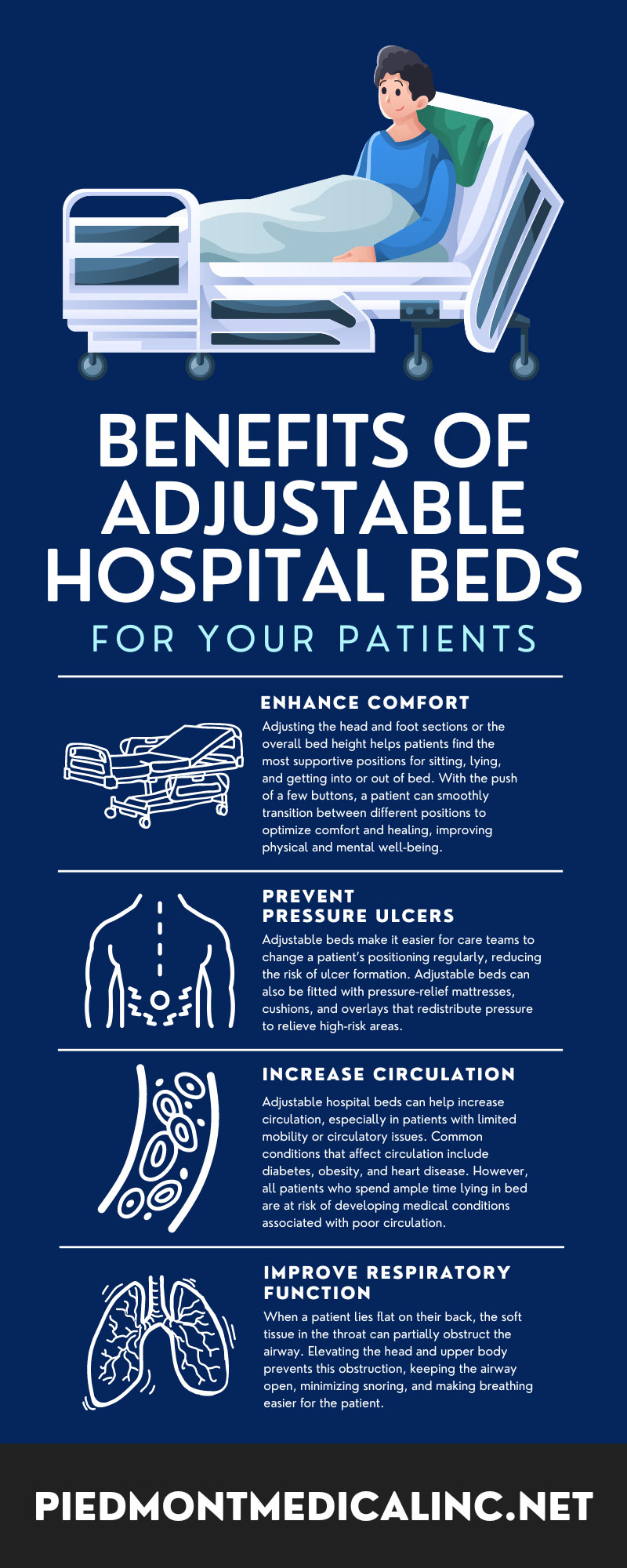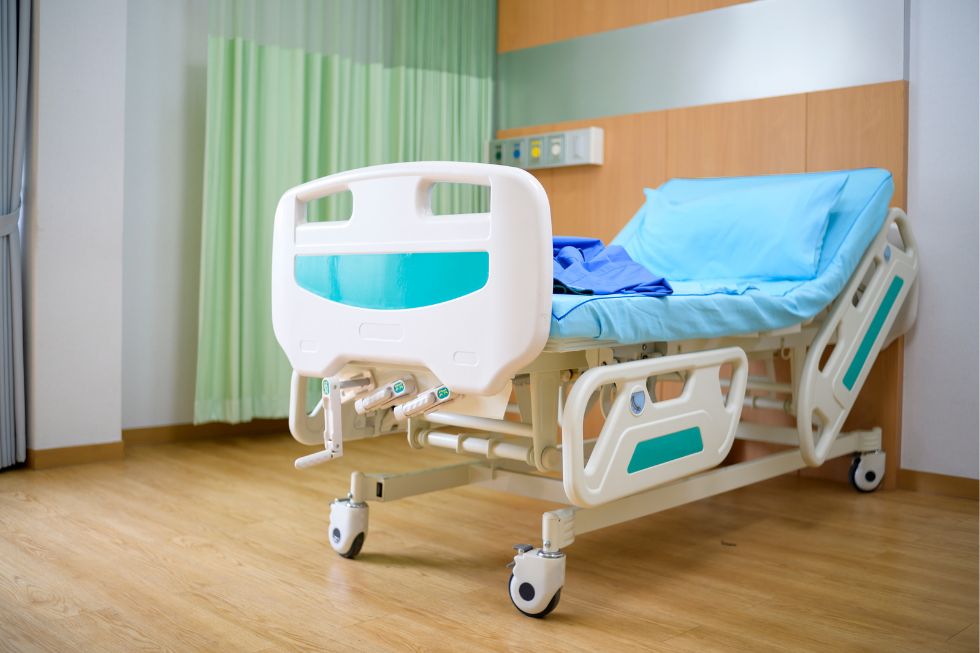Adjustable hospital beds are essential in modern healthcare for supporting patient recovery and improving well-being. Adjustable beds can improve clinical outcomes by helping both patients and care teams.
Electric hospital beds move smoothly and efficiently for precise positioning, and they’re an essential tool for patient recovery. Explore the benefits of adjustable hospital beds for your patients.
Enhance Comfort
Adjustable hospital beds allow patients and medical staff to customize bed positioning. The bed can meet any patient’s unique needs thanks to multiple adjustable sections.
Adjusting the head and foot sections or the overall bed height helps patients find the most supportive positions for sitting, lying, and getting into or out of bed. With the push of a few buttons, a patient can smoothly transition between different positions to optimize comfort and healing, improving physical and mental well-being.
Prevent Pressure Ulcers
Another benefit of adjustable hospital beds for patients is that they help prevent pressure ulcers. Patients who must stay in bed and those with limited mobility are at an increased risk of developing painful pressure ulcers, also called bedsores.
Adjustable beds make it easier for care teams to change a patient’s positioning regularly, reducing the risk of ulcer formation. Adjustable beds can also be fitted with pressure-relief mattresses, cushions, and overlays that redistribute pressure to relieve high-risk areas.
Increase Circulation
Adjustable hospital beds can help increase circulation, especially in patients with limited mobility or circulatory issues. Common conditions that affect circulation include diabetes, obesity, and heart disease. However, all patients who spend ample time lying in bed are at risk of developing medical conditions associated with poor circulation.
Poor circulation can cause discomfort, tingling, swelling, and cramps. Poor circulation also slows recovery and can worsen symptoms.
A patient can adjust the bed to alleviate limb pressure and keep the spine aligned—the patient’s condition and personal preference help determine the best positioning. To support good circulation, side sleepers should sleep on their left side when possible.
Improve Respiratory Function
Elevating the patient’s head or upper body can improve breathing function. This advantage is great for all patients, but those with postnasal drip or respiratory conditions like sleep apnea and snoring may find it particularly beneficial.
When a patient lies flat on their back, the soft tissue in the throat can partially obstruct the airway. Elevating the head and upper body prevents this obstruction, keeping the airway open, minimizing snoring, and making breathing easier for the patient.
Snoring, sleep apnea, and mouth-breathing can cause daytime fatigue, headaches, and poor focus. Give patients a restful night’s sleep with adjustable hospital beds.
Tip: Always Adjust Positioning Supports
Adjustable beds will make placing patients in optimal positions easier and more secure, but positioning supports, such as pillows and cushions, may need further adjustment. For example, Fowler’s position, also called the sitting position, promotes lung expansion and is useful for patients with respiratory problems. Patients in Fowler’s position may sometimes need to rest without a pillow to promote neck extension.
Offer Relief From Acid Reflux and GERD
Acid reflux is characterized by stomach acid flowing up into the esophagus. The backwash of stomach acid irritates the esophageal lining and causes symptoms including a burning sensation in the chest (heartburn), trouble swallowing, and upper abdominal or chest pain.
Gastroesophageal reflux disease (GERD) is a more intense form of acid reflux in which the stomach acid backflow is chronic and damages the body over time. Frequent acid reflux can cause GERD to develop.
With an adjustable bed, a patient can alleviate acid reflux and heartburn by raising the head portion to rest in a reclined state. In this position, gravity helps keep stomach acid down to lessen the risk of reflux.
Achieve Therapeutic Post-Surgical Positioning
Correct post-surgical positioning promotes healing and prevents complications. Maintain the integrity of surgical incisions and closures and improve the overall recovery process with an adjustable bed.
The surgical team may provide recommendations and instructions for postoperative sleeping positions. The guidelines will depend on the patient’s condition, the type of surgery performed, and other factors.
An adjustable bed also improves sitting positions. For example, adjustable beds can be positioned to support the patient in a sitting position, with an overbed table topped with pillows to lean on. This position, called the orthopneic or tripod position, maximizes lung expansion and makes exhaling easier.
Tip: Augment the Bed With Cushions and Pads
Adjusting the bed will help with overall comfort and mobility. Positioning devices can further customize support. Specialized cushions or pads can ensure direct pressure is not applied to the incision site.
Typically, patients who have had surgeries on their arms or legs elevate the affected limbs to reduce swelling. A patient or care provider can adjust the bed and use supportive pillows and foam wedges to keep these limbs in position.
Support Pain Management
Persistent pain is a common issue for hospitalized patients. An adjustable bed can alleviate back, neck, and joint pain, making it easier to precisely position patients and minimize discomfort.
Elevating certain body parts can relieve pressure on painful areas. Redistributing pressure and improving circulation reduces pain and leads to better tissue oxygenation.
Adequate pain control can lead to faster recovery. Inadequately controlled pain can lead to complications such as decreased lung function and problems with cognitive processes. Reducing pain can help patients feel more at ease and improve their mental and emotional state.
Using an adjustable bed for pain management can also improve treatment compliance. Pain can prevent patients from participating fully in physical therapy, but managing pain can help patients comply with their care plans and achieve better outcomes.
Support Caregivers and Medical Staff
Finally, an adjustable bed helps ease the workload for caregivers and medical staff. Automatically adjusting a bed’s height and the position of the head and feet reduces the strain on caregivers’ backs when changing linens, administering treatments, assisting with hygiene, and performing other patient care tasks. User-friendly controls make it easy to adjust the beds efficiently.
An adjustable bed can also empower patients to retain mobility and independence during recovery. With the ability to adjust the bed’s height, patients can get in and out of bed more easily, reducing the risk of falls. For patients who use mobility aids, an adjustable bed facilitates safer transfers that may improve confidence.
Provide safety and comfort for your patients with adjustable hospital beds from Piedmont Medical. We professionally restore each of our reconditioned hospital beds to like-new condition to achieve the highest safety and functionality standards. Shop with us today to improve your patients’ recovery experiences at your medical care facility.



Recent Comments